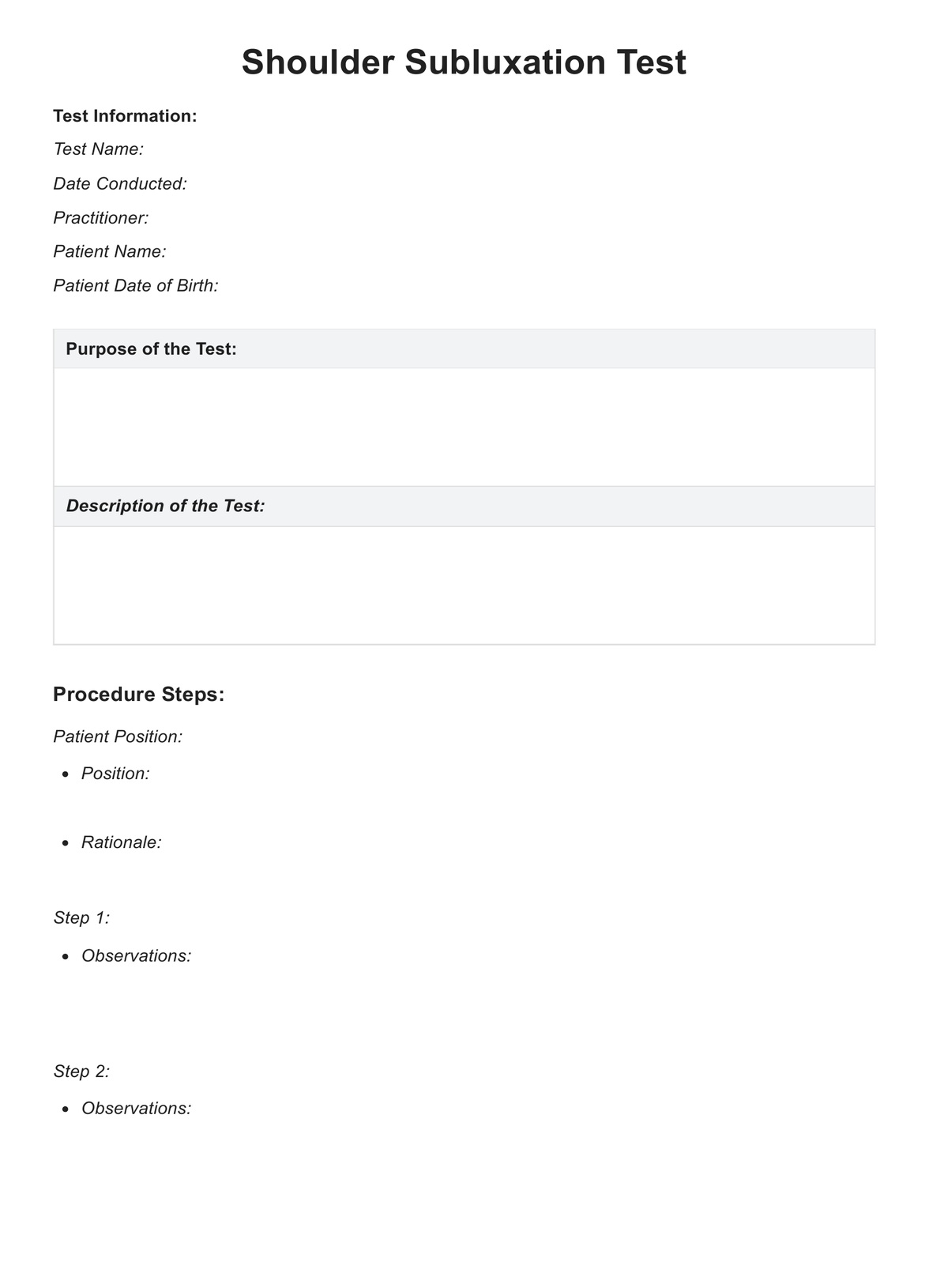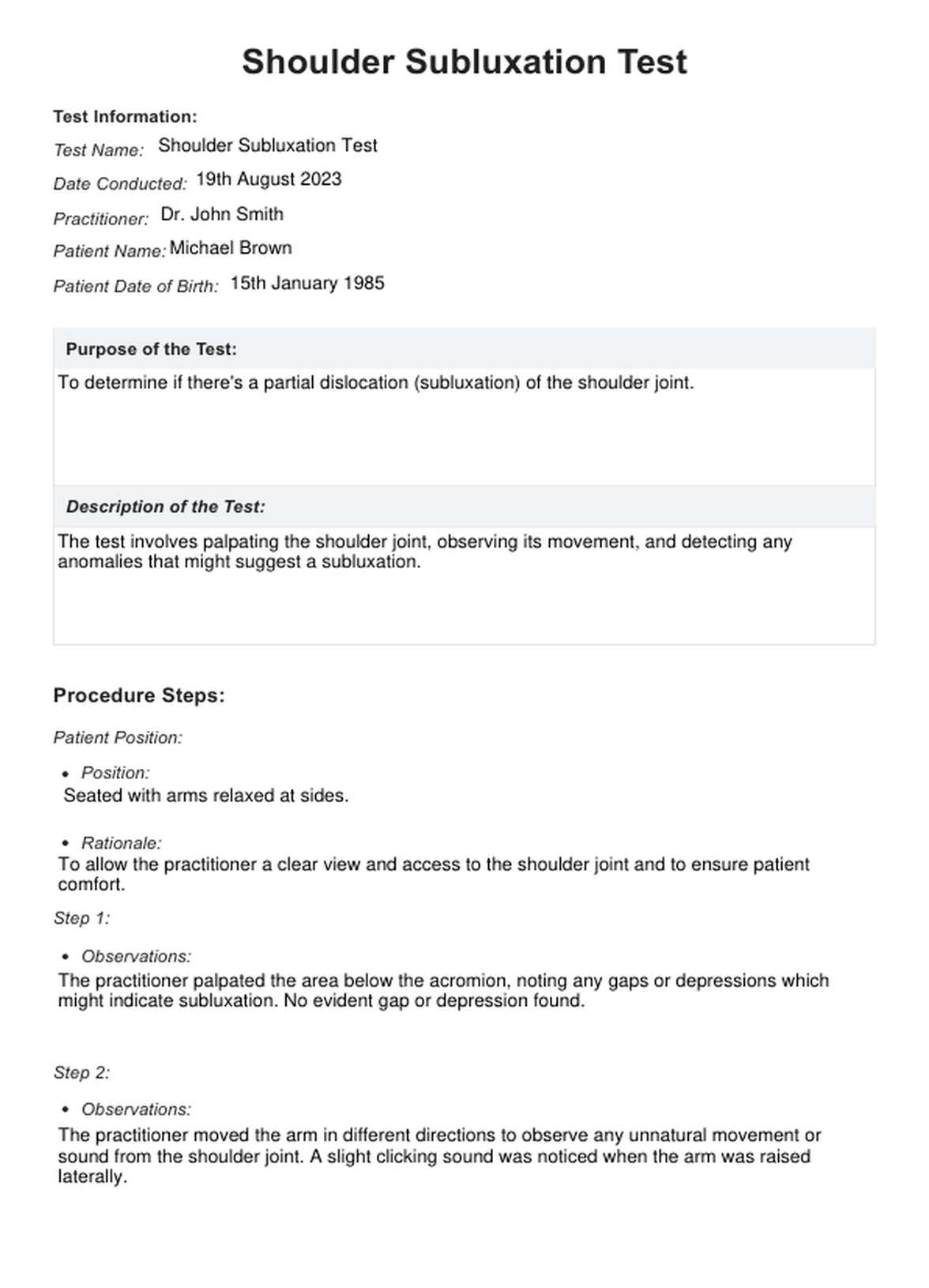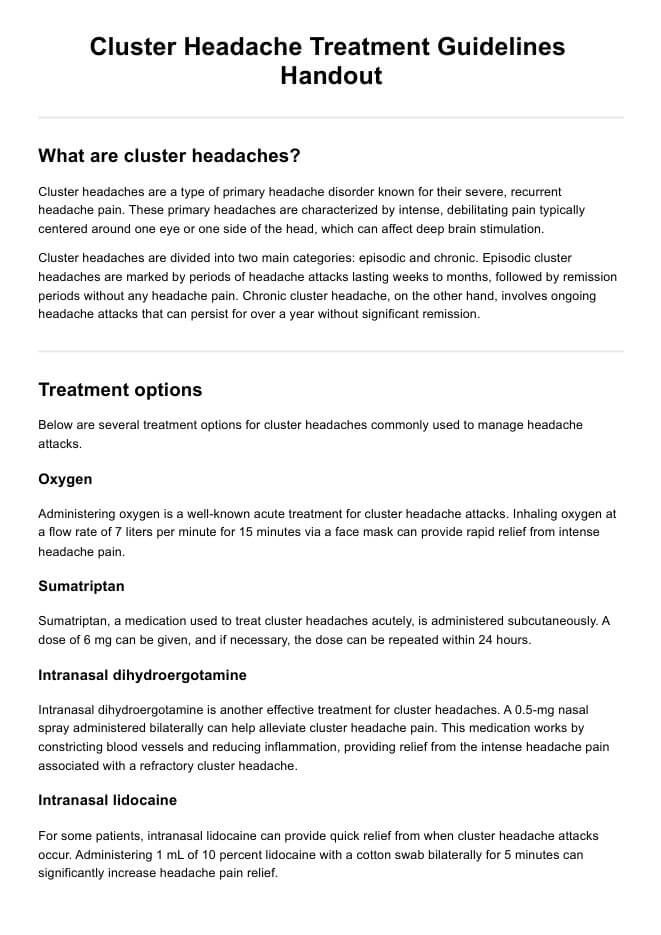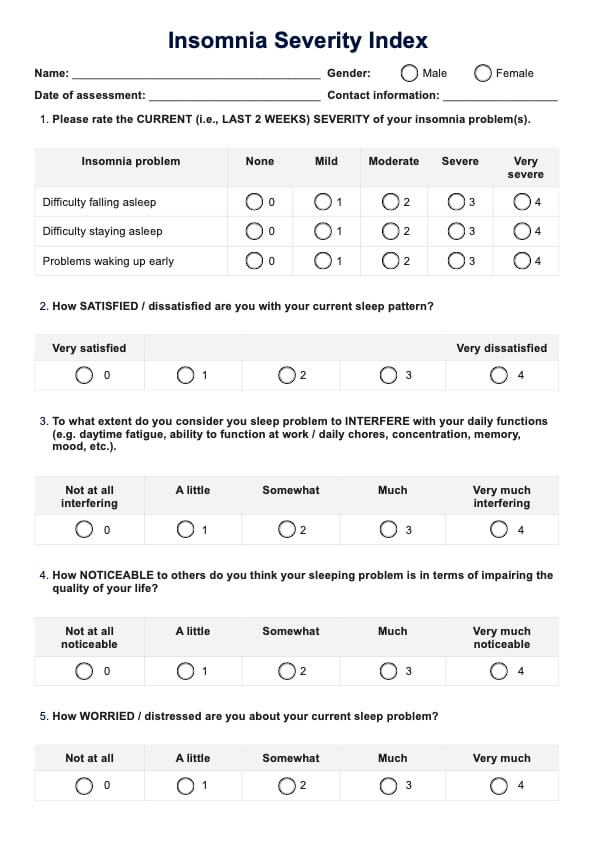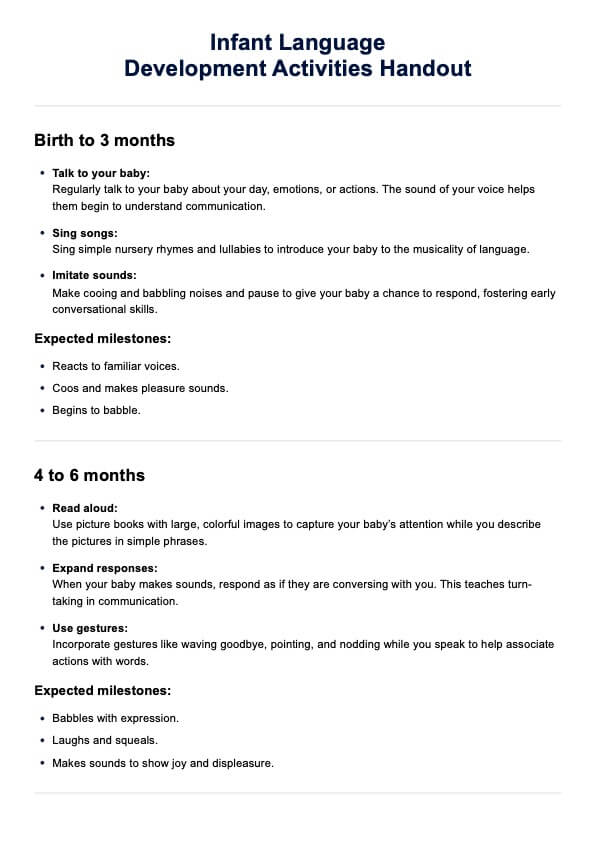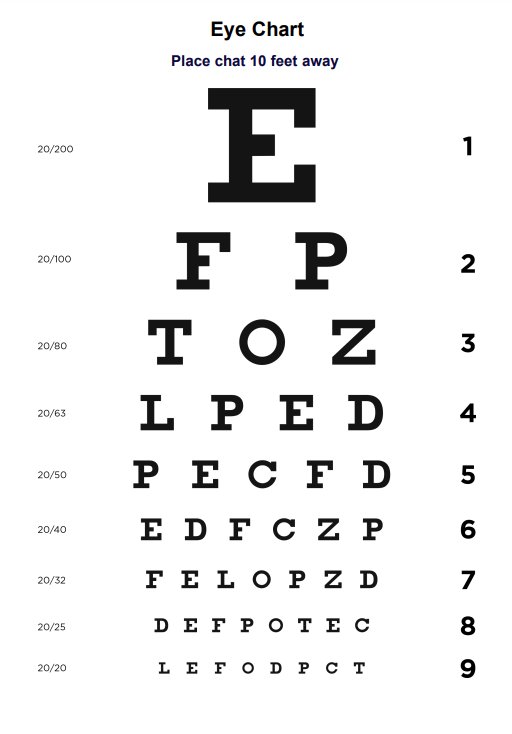Shoulder Subluxation Tests
Optimize your Shoulder Subluxation Tests with Carepatron. Our globally compliant, user-friendly software simplifies test management for superior patient care.


What is a Shoulder Subluxation Test?
A Shoulder Subluxation Test is a comprehensive clinical evaluation conducted by healthcare professionals to identify the presence of partial shoulder dislocation, also known as subluxation. In this condition, there's an incomplete or temporary dislocation of the shoulder joint where the head of the upper arm bone (humerus) partially slips out from the socket (glenoid) of the shoulder blade (scapula).
This condition is often associated with symptoms such as localized pain, muscle weakness, numbness, and a noticeable decrease in the range of shoulder movement. Tests are performed to diagnose this, including apprehension, relocation, and load and shift tests. Each of these tests involves specialized maneuvers of the arm and shoulder to evaluate joint stability and detect any abnormal movement that indicates a subluxation.
To better comprehend the procedure and execution of these tests, we've prepared an insightful explainer video that provides a visual demonstration. This video will guide you through the process, making it easier to understand the steps involved in each test.
For an in-depth understanding and step-by-step guidance on conducting these tests, we invite you to visit our page. Here, you'll find extensive information to help you better understand shoulder subluxation tests and their importance in diagnosing shoulder instability.
Shoulder Subluxation Tests Template
Shoulder Subluxation Tests Example
How does it work?
The Shoulder Subluxation Test is a systematic examination involving several steps designed to assess the stability and functionality of the shoulder joint effectively. Here's how it works:
Step 1: Positioning the Patient
The first step involves positioning the patient so the healthcare provider can easily access and have a clear shoulder view. The patient may be asked to sit upright or lie down based on the type of test being performed and the patient's comfort. This step is crucial as it sets the foundation for the subsequent stages of the test.
Step 2: Execution of the Test
In this phase, the healthcare professional conducts the test by manipulating the shoulder in distinct ways or applying gentle pressure. This could involve rotating the arm in specific directions or exerting pressure at certain points. The professional meticulously observes the patient's reactions, especially any signs of discomfort and abnormal shoulder movement during these manipulations.
Step 3: Recording Observations and Findings
Upon performing the test, the healthcare provider documents their observations and findings. This includes noting any visible signs of shoulder subluxation, such as the abnormal motion of the shoulder, resistance to certain movements, or expressions of pain. Accurate recording of these observations is vital as it forms the basis of diagnosis and treatment planning.
Step 4: Interpretation of Results
The final step involves interpreting the results of the test. The healthcare professional evaluates the documented observations, determining whether they indicate shoulder subluxation. Common positive signs include visible abnormal shoulder movement, patient apprehension, or discomfort during the test.
Understanding each process step can make the experience more manageable for patients and ensure that healthcare professionals perform the test correctly and efficiently. To aid this understanding, we have prepared printable Shoulder Subluxation Tests for your reference. This document provides a detailed breakdown of the process and can guide patients and healthcare providers.
When would you use this Form?
The Shoulder Subluxation Test Form is a valuable tool widely used by healthcare professionals, including physiotherapists, orthopedic surgeons, and sports medicine specialists. It's essential when patients present symptoms that suggest potential shoulder instability or injuries.
These tests are primarily employed when patients report acute or chronic pain, instability, or a shoulder sensation 'giving way' during certain activities. These could be signs of possible shoulder subluxation, necessitating comprehensive evaluation through these tests.
Athletes are often prone to shoulder injuries, given their high level of physical activity and strain on the body. Therefore, sports medicine specialists frequently use these tests to diagnose and manage potential shoulder subluxations in athletes. This allows for timely interventions and appropriate treatment plans, ensuring quick recovery and preventing further injuries.
Similarly, individuals who have experienced shoulder trauma, such as an accident or fall, are potential candidates for these tests. Orthopedic surgeons often use the Shoulder Subluxation Test Form to assess the extent of the injury and determine if a partial dislocation has occurred.
Moreover, these tests are also useful in persistent or recurrent shoulder pain, even without a known injury or trauma. Chronic shoulder pain can sometimes indicate a subtle subluxation that is not apparent in regular examinations. Healthcare professionals can accurately diagnose these conditions and initiate appropriate therapeutic interventions using the Shoulder Subluxation Test Form.
You can use the clinical evaluation template to enhance your practice and achieve better patient outcomes. This template streamlines the assessment process, ensuring thorough and consistent evaluations.
Benefits
The Shoulder Subluxation Test Form offers numerous benefits, making it an invaluable tool in managing shoulder injuries. Here are some key advantages:
Simplified and Fast Assessment
One of the primary benefits of these tests is their simplicity and speed. They provide a quick and straightforward method for assessing shoulder stability, eliminating the need for complex equipment or lengthy procedures. This makes them accessible and easy to incorporate into regular clinical practice.
Facilitating Early Detection
These tests play a crucial role in the early detection of shoulder subluxation. Identifying this condition early can prevent further injury by allowing timely intervention. It also guides healthcare professionals in determining the most appropriate treatment methods, enhancing patient outcomes.
Personalized Treatment Plans
The results derived from these tests are instrumental in developing a personalized treatment plan tailored to the patient's specific needs. For instance, if the tests indicate shoulder subluxate, the treatment plan may include shoulder subluxation exercises to strengthen the shoulder muscles and improve joint stability.
Tracking Recovery Progress
Another significant benefit of these tests is the ability to monitor the effectiveness of the treatment plan. Regular testing can track recovery progress, providing valuable insights into whether the current treatment approach works or if adjustments are needed.
Download our free Shoulder Subluxation Tests form to reap these benefits and conduct a comprehensive assessment. This resource offers a systematic approach to evaluating shoulder stability, contributing significantly to managing shoulder injuries.
Research & Evidence
The reliability and effectiveness of shoulder subluxation tests have been validated through numerous studies and research. These tests have proven valuable diagnostic tools in identifying shoulder instability and guiding subsequent treatment plans.
Research has consistently shown shoulder subluxation tests to be reliable tools for diagnosing shoulder instability. For instance, a study published in the American Journal of Occupational Therapy examined the reliability of clinical measurement of shoulder subluxation based on palpation. The results underscored the test's reliability, supporting its use in clinical practice.
Furthermore, another study highlighted the reliability of three methods used to evaluate changes in shoulder subluxation. The study involved thirty-six patients with shoulder subluxation, and each rater repeated her assessments on nine subjects to test the reliability of the methods. The findings reinforced the credibility of these tests as reliable measures of shoulder subluxation.
A separate study focused on a radiological measure of shoulder subluxation in hemiplegia patients. The research aimed to test the reliability and construct validity of the measure, which was found to discriminate effectively between readings taken of subluxated and non-subluxated shoulders. This study further validates the use of shoulder subluxation tests in clinical settings.
Moreover, evidence supporting the use of these tests extends beyond their reliability. Studies have demonstrated their effectiveness in identifying subluxations and guiding treatment plans. For instance, research on the effects of functional electrical stimulation on shoulder subluxation, arm function recovery, and shoulder pain in hemiplegic stroke patients indicated that shoulder subluxation tests could facilitate recovery by informing appropriate treatment interventions.
The body of research and evidence validates shoulder subluxation tests. They offer reliable assessment methods and contribute significantly to developing effective treatment plans for patients experiencing shoulder instability. This makes them invaluable tools in the field of healthcare.
References
- https://www.healthline.com/health/shoulder-subluxation
- https://www.ncbi.nlm.nih.gov/books/NBK507847/
- https://www.physio-pedia.com/Shoulder_subluxation
- https://orthoinfo.aaos.org/en/diseases--conditions/chronic-shoulder-instability/
Commonly asked questions
Physiotherapists, orthopedic surgeons, and sports medicine specialists typically use Shoulder Subluxation Tests.
Shoulder Subluxation Tests are used when a patient presents with shoulder pain or instability, particularly after a shoulder injury or trauma.
Shoulder Subluxation Tests involve specific movements of the arm and shoulder to assess stability and identify any abnormal motion. The healthcare professional observes the patient's reactions and any abnormal movement in the shoulder.

.jpg)
